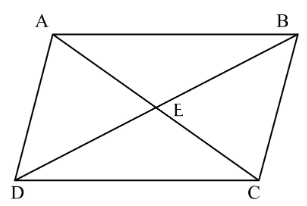FIND THE MISSING VERTICES OF A PARALLELOGRAM
Properties of parallelogram :
- Diagonals bisect each other.

Midpoint of diagonal AC = Midpoint of diagonal DB
Problem 1 :
Show that the points A(3, 1), B(0, -2), C(1, 1) and D(4, 4) are the vertices of a parallelogram ABCD.
Solution:
The given points are A(3, 1), B(0, -2), C(1, 1) and D(4, 4).
Thus, AB = CD = √18 units and BC = AD = √10 units.
Opposite sides are equal.
So, quadrilateral ABCD is a parallelogram.
Problem 2 :
If the points P(a, -11), Q(5, b), R(2, 15) and S(1, 1) are the vertices of a parallelogram PQRS, find the value of a and b.
Solution:
Midpoint of PR = Midpoint of QS
Equating x and y-coordinates, we get
|
|
|
So, the value of a and b are 4 and 3.
Problem 3 :
If three consecutive vertices of a parallelogram ABCD are A(1, -2), B(3, 6) and C(5, 10). Find the fourth vertex D.
Solution:
Let the fourth vertex be D(a, b).
Midpoint of AC = Midpoint of BD
Equating x and y-coordinates, we get
|
|
|
Therefore, the fourth vertex is D(3, 2).
Problem 4 :
If the points A(6, 1), B(8, 2), C(9, 4) and D(p, 3) are the vertices of a parallelogram, taken in order, find the value of p.
Solution:
Midpoint of AC = Midpoint BD
So, the value of p is 7.
Problem 5 :
If the points A(-2, -1), B(a, 0), C(4, b) and D(1, 2) are the vertices of a parallelogram, taken in order, find the value of a and b.
Solution:
Mid point of AC = Mid point of BD
The coordiante of the mid point of a line formed by joining two points (x1, y1) and (x2, y2) are
By equating x and y-coordinates,
|
|
|
So, the values of a and b are 1 and 3.
Recent Articles
-
Finding Range of Values Inequality Problems
May 21, 24 08:51 PM
Finding Range of Values Inequality Problems -
Solving Two Step Inequality Word Problems
May 21, 24 08:51 AM
Solving Two Step Inequality Word Problems -
Exponential Function Context and Data Modeling
May 20, 24 10:45 PM
Exponential Function Context and Data Modeling